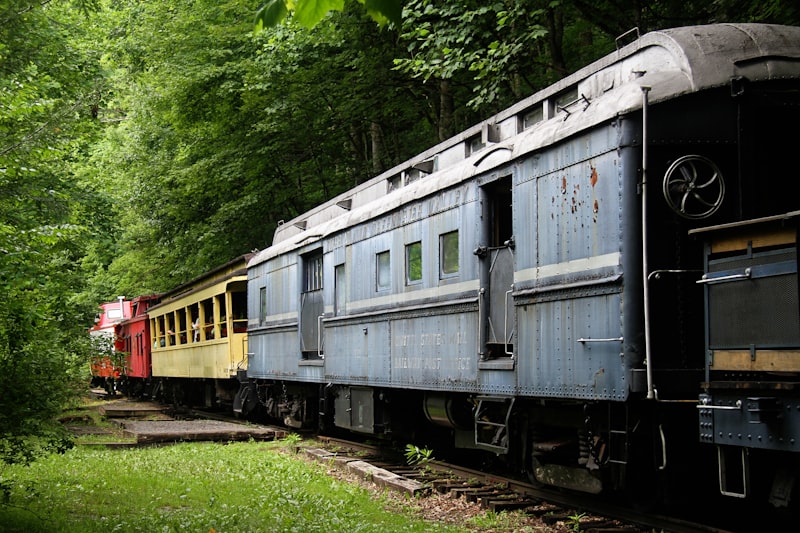Imagine stepping off a train into a world of grandeur and history at Madrid’s Atocha Station. This station, with its vast interior garden filled with tropical plants and ponds teeming with turtles, feels more like a botanical paradise than a bustling transit point. It’s a place where modernity meets nature, offering travelers a serene welcome or farewell to Spain’s vibrant capital.
In the heart of Paris, the Gare du Nord stands as a testament to the city’s elegance and grandeur. Serving as a gateway to France and beyond, this station’s architecture exudes the essence of Belle Époque with its soaring arched windows and intricate ironwork. It’s not just a place to catch a train; it’s a destination in itself where history whispers through every corner.
Moving eastward, Prague’s Main Railway Station (Hlavní Nádraží) transports visitors back in time with its Art Nouveau façade and ornate detailing. The station’s exterior, adorned with sculptures and topped by a clock tower, evokes a sense of nostalgia for a bygone era. Inside, the bustling atmosphere blends seamlessly with the station’s historical charm, making it a favorite among photographers and travelers alike.
Heading north to Stockholm, the Central Station (Stockholms Centralstation) welcomes travelers with its imposing granite structure and bustling concourse. Here, travelers can marvel at the juxtaposition of modern efficiency and historic architecture, all while being in the heart of Sweden’s capital city.
Further south, in Italy, Milan’s Stazione Centrale greets visitors with its grand neoclassical façade and vast interior spaces adorned with mosaics and statues. It’s a station where art meets functionality, offering a glimpse into Italy’s rich cultural heritage right from the moment travelers step off the train.
Hidden Gems: Exploring Europe’s Most Charming Train Stations
Take, for instance, the Gare de Lyon in Paris. This station isn’t just a place to catch a train; it’s a majestic ode to the Belle Époque era. Its grand façade adorned with intricate carvings and clock tower exudes an old-world charm that transports you to a bygone Parisian era of romance and sophistication. As you walk through its bustling corridors, you can almost hear echoes of past travelers bidding farewell or reuniting under its iconic arched roof.
Moving eastward, the Keleti Railway Station in Budapest is another architectural gem that blends art nouveau and baroque styles. Its sweeping arches and ornate decorations evoke a sense of grandeur fitting for a city known as the “Paris of the East.” Imagine boarding a train amidst the station’s elaborate ironwork and stained glass windows, feeling as though you’ve stepped into a living museum where each corner tells a different story of Hungary’s rich cultural heritage.
Not all hidden gems are in capital cities, though. The Cinque Terre region in Italy boasts the Manarola Train Station, where visitors are greeted with breathtaking views of the Ligurian Sea and colorful cliffside villages. The station itself is unassuming yet perfectly integrated into its stunning surroundings, making it a starting point for exploring one of Italy’s most picturesque destinations.
These stations aren’t just stops on a journey; they are destinations in their own right, offering travelers a chance to immerse themselves in history, art, and culture while marveling at architectural marvels that have stood the test of time. Whether you’re a history enthusiast, an architecture buff, or simply a traveler seeking beauty in unexpected places, Europe’s charming train stations promise an unforgettable experience that goes beyond mere transportation.
Architectural Marvels: Europe’s Stunning Railway Stations Revealed
Take the St. Pancras International in London, for instance. Its towering Victorian Gothic facade is like a grand entrance to a historical monument rather than a mere station. The intricate detailing on its exterior, reminiscent of an era long past, captivates visitors and locals alike. Inside, the vast train shed with its iconic arched roof made of iron and glass is a marvel of engineering, flooding the station with natural light that dances off the polished platforms.
Moving to Paris, Gare du Nord stands as a testament to French architecture. Serving as a gateway to the city of lights, its facade is a stunning example of Belle Époque design, adorned with sculptures and intricate decorations that reflect the cultural richness of the era. The station buzzes with activity, its interior bustling with commuters and travelers amidst the elegant blend of classical and modern elements.
In Berlin, the Hauptbahnhof embodies contemporary architectural prowess. With its sleek steel and glass structure, it symbolizes Germany’s commitment to modernity and efficiency. The station’s spacious design and innovative use of materials create a sense of openness and connectivity, making it not just a transit point but a destination in itself.
Rome’s Termini Station, on the other hand, blends classical Roman architecture with functional modernity. Serving as the largest railway station in Italy, it combines the grandeur of marble columns and vaulted ceilings with the practicality of state-of-the-art facilities, accommodating millions of passengers annually while retaining its historical charm.
Journey Through Beauty: Europe’s Top 10 Picturesque Train Stations
Embarking on a journey through Europe is not just about reaching your destination but also about the breathtaking beauty you encounter along the way. Europe’s train stations are not merely transit hubs; they are architectural marvels that tell stories of history and culture. Let’s explore some of the continent’s most picturesque train stations that make every traveler pause in awe.
Imagine stepping into Zurich Hauptbahnhof, where the grandeur of its glass roof allows natural light to flood the platforms, creating a stunning contrast against the bustling crowds. It’s not just a station; it’s an experience of modern elegance blended with old-world charm.
Venture to Antwerp’s Centraal Station, a cathedral-like masterpiece adorned with iron and glass, where the play of light creates a mesmerizing dance of shadows. It’s a place where architecture meets art, offering travelers a glimpse into Belgium’s rich artistic heritage.
In Prague, the Main Railway Station welcomes you with its historic façade and intricate detailing, transporting you to a bygone era of elegance and sophistication. It’s a station that whispers tales of Bohemian culture and architectural prowess.
For those enchanted by Nordic charm, Stockholm Central Station is a beacon of Scandinavian design, with its spacious halls and minimalist aesthetic that exude tranquility amidst the urban hustle.
Further south, Venice’s Santa Lucia Station emerges like a grand palazzo on the water, reflecting the city’s romantic allure with every arriving train.
As you traverse Europe’s railway network, each station reveals its own narrative through design, blending functionality with artistic expression. Whether you’re a seasoned traveler or embarking on your first European adventure, these top 10 picturesque train stations promise a journey filled with wonder and discovery.
Beyond Travel: Discovering Europe’s Iconic Train Station Landmarks
Ever wondered how much history and beauty are packed into Europe’s iconic train stations? These hubs of travel aren’t just places to catch a train; they’re landmarks that tell stories of architectural marvels, cultural intersections, and the pulse of bustling cities. Let’s embark on a journey through some of Europe’s most iconic train stations, where each stop offers a glimpse into the region’s rich tapestry.

Imagine stepping into Grand Central Terminal in New York City, but now transport that feeling to the heart of Europe. Paris greets travelers with Gare du Nord, a station that feels like a gateway to the soul of the city itself. Its grand façade and bustling platforms are more than just a place to catch the Eurostar; they’re a microcosm of Parisian life, where travelers from all corners of the globe intersect.
Venture further east to Berlin’s Hauptbahnhof, where modernity meets history seamlessly. This architectural marvel seamlessly integrates glass and steel into the fabric of Berlin’s landscape, symbolizing the city’s journey from division to unity. The station not only serves as a vital transportation hub but also as a symbol of resilience and innovation in the heart of Germany.

Italy’s Milan Central Station is another gem worth exploring. Its majestic design, with its vaulted glass and iron roof, evokes a sense of grandeur fitting for a city known for its fashion and art. Here, travelers can experience the fusion of classical architecture with modern amenities, all while catching a train to Italy’s picturesque destinations.
As we journey through these iconic stations, each one offers more than just a platform; it offers a glimpse into the soul of its city and its people. From the romantic allure of Amsterdam’s Centraal Station to the timeless elegance of London’s St. Pancras International, these landmarks transcend their function to become cultural touchstones.
Next time you find yourself at a European train station, take a moment to soak in its history and architectural splendor. These stations aren’t just stops on a map; they’re chapters in Europe’s ongoing narrative, where every arrival and departure adds to the tapestry of human experience and connection.
From Classic to Modern: Europe’s Diverse Railway Architectures
Imagine stepping into a classic European railway station, where towering arches and ornate ceilings greet travelers like remnants of a bygone era. These stations, often nestled in historic city centers, exude a charm that blends seamlessly with their surroundings. For instance, Paris’ Gare du Nord, with its majestic facade and bustling atmosphere, reflects the 19th-century architectural prowess that defined the era of steam-powered locomotives.
In contrast, modern railway stations across Europe embrace contemporary architectural trends while prioritizing functionality and sustainability. Take Berlin Hauptbahnhof, a marvel of glass and steel, symbolizing Germany’s post-reunification ambition and efficiency. Its airy spaces and cutting-edge design not only facilitate smooth transit but also serve as architectural landmarks in their own right.
The shift from classic to modern railway architectures mirrors Europe’s journey through industrialization and urbanization. Classic stations, with their intricate detailing and solid masonry, evoke a sense of nostalgia for the romanticism of early train travel. They stand as reminders of an era when railroads connected distant cities and transformed travel into an adventure.
On the other hand, modern railway stations embrace minimalist aesthetics and eco-friendly technologies. Stations like London’s St Pancras International seamlessly blend historic Victorian architecture with contemporary elements, showcasing Europe’s commitment to preserving heritage while embracing innovation.
Across Europe, each railway station tells a unique story shaped by its architectural style. From the ancient stone of Rome’s Termini Station to the futuristic curves of Lyon-Saint Exupéry TGV, every station reflects not only the technological advancements of its time but also the cultural identity of its location.
Scenic Stops: Europe’s Most Instagrammable Train Stations
Imagine stepping into a world where train stations are not just transit points but destinations in themselves. Picture intricate ironwork and grand facades that tell stories of centuries past, or sleek contemporary designs that reflect the cutting edge of modern architecture. Each station is a unique blend of history, culture, and artistic expression, waiting to be explored and admired.
One such gem is Madrid’s Atocha Station, where the old meets the new in a stunning tropical garden setting. Its iconic glass ceiling bathes the station in natural light, creating a tranquil oasis amidst the hustle and bustle of city life. A perfect spot for travelers to pause, capture a moment of serenity, and share it with the world.
Moving north, Stockholm’s T-Centralen stands out with its vibrant underground art gallery. Here, commuters are greeted by intricate murals and sculptures that transform the station into a subterranean masterpiece. It’s not just a place to catch a train but an immersive cultural experience that sparks creativity and wonder.
In the heart of Paris, Gare du Nord enchants visitors with its majestic architecture and bustling atmosphere. As one of the busiest stations in Europe, it offers a glimpse into the city’s rich history and cosmopolitan charm. Whether it’s the ornate facade or the constant ebb and flow of travelers, every corner of Gare du Nord tells a story waiting to be shared.
Travelers seeking a blend of old-world charm and modern allure will find it in Milan’s Stazione Centrale. Its grandiose architecture and intricate detailing make it a favorite among architecture enthusiasts and photographers alike. From the monumental entrance hall to the intricate marble floors, every detail invites exploration and appreciation.
These are just a few examples of Europe’s most Instagrammable train stations, each offering a unique perspective on the art of travel. Whether you’re capturing the elegance of a bygone era or the innovation of contemporary design, these stations inspire awe and curiosity in equal measure. So next time you find yourself at a train station in Europe, take a moment to look beyond the platform and discover the beauty that lies within.
Heritage and Design: The Story Behind Europe’s Most Beautiful Stations
Take Amsterdam Centraal, a Gothic-Renaissance masterpiece overlooking the bustling city and serene waters. Its grand facade and intricate details reflect the city’s rich maritime past, with soaring arches and ornate ironwork that echo an era of Dutch exploration and trade.
In Barcelona, Estació de França embodies Catalan Modernism, designed by the legendary architect Lluís Domènech i Montaner. Its sweeping curves, delicate stained glass, and sculpted motifs evoke a sense of artistic rebellion and cultural pride during Catalonia’s Renaissance.
Moving eastward, Moscow’s Kazansky Railway Station stands as a testament to Russian Imperial architecture. Its imposing facade and golden domes echo the grandeur of the Romanov dynasty, blending Byzantine and Russian architectural styles into a symbol of imperial power and national identity.
Paris’s Gare du Nord, Europe’s busiest train station, marries 19th-century elegance with contemporary functionality. Its iconic clock tower and bustling platforms symbolize Parisian chic and the city’s role as a global cultural hub.
In Vienna, the Hauptbahnhof merges modernity with Viennese tradition. Designed for efficiency and sustainability, its sleek glass and steel structure harmonize with the city’s Baroque and Art Nouveau heritage, reflecting Austria’s commitment to innovation and environmental responsibility.
Frequently Asked Questions
Are the most picturesque European train stations accessible to tourists?
Discover which European train stations offer the most picturesque views and are accessible for tourists. Find out where you can experience stunning architecture and scenic surroundings while traveling by train.
Can I take photos inside the most picturesque European train stations?
Find out if photography is permitted inside Europe’s most scenic train stations with our clear FAQ. Learn about the rules and recommendations for capturing memorable moments in these iconic locations.
How can I visit the most beautiful train stations in Europe?
Learn how to visit Europe’s most stunning train stations with our concise guide. Discover insider tips for planning your journey, including must-see stations and efficient travel routes.
What makes a train station picturesque in Europe?
Discover what features make European train stations picturesque. Learn about architectural styles, historical significance, scenic surroundings, and cultural elements that contribute to their charm.
What are the top 5 most picturesque train stations in Europe?
Discover Europe’s top 5 most picturesque train stations, each offering unique architectural charm and scenic surroundings that captivate travelers.


